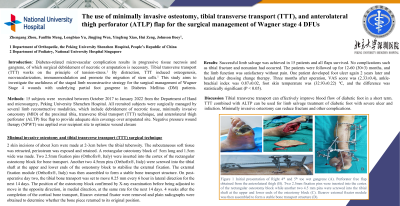Clinical Research
(CR-067) The application of minimally invasive osteotomy, tibial transverse transport (TTT) technique and anterolateral thigh perforator (ATLP) flap for the surgical management of Wagner stage 4 DFU
Friday, April 28, 2023
7:15 PM - 8:30 PM East Coast USA Time

Longbiao Yu, MD – Consultant, Department of Hand and microsurgery, Peking University Shenzhen Hospital; FanBin Meng, MD – Department of Hand and microsurgery – Peking University Shenzhen Hospital; JingJing Wen, MD – Consultant, Department of Hand and microsurgery, Peking University Shenzhen Hospital; Johnson Boey, CWSP, FRCPSG (Glasgow), DPM – Attending Podiatrist, Podiatry, NUH
Introduction: Diabetes-related microvascular complication has been associated with tissue necrosis eventually leading to gangrene, which necessitate the localized tissue debridement or amputation. This study aim to investigate the usefulness of the staged limb reconstructive strategy for the management of partial foot gangrene in patients diagnosis with type 2 diabetes mellitus (T2DM).
Methods: A retrospective study involving 15 patients recruited from October 2017 to January 2022 at the Department of Hand and microsurgery, Peking University Shenzhen Hospital. These patients have diagnosis of type 2 diabetes at the time of recruitment and presented with some level of partial foot gangrene (as classified as Wagner Stage 4 ulceration) that are surgical managed by staged limb reconstructive strategies. These involves a combination of surgical debridement of necrotic tissue, minimally invasive osteotomy (MIO) of the proximal tibia, transverse tibial transport (TTT) technique, and finally wound closure with anterolateral thigh perforator flap. Negative pressure wound therapy (NPWT) was utilized to optimize wound management and tibial bone stabilization during TTT was made with Ilizarov external fixator.
Results: Successful limb salvage was achieved in 15 patients and all flaps survived. No complications such as tibial fracture and nonunion had occurred. The patients were followed up for 12-60 (30±3) months, and the limb function was satisfactory without pain. One patient developed foot ulcer again 2 years later and healed after dressing change therapy. Three months after operation, VAS score was (2.33±0.4), ankle-brachial index was 0.87±0.02, foot skin temperature was (32.93±0.22) ℃, and the difference was statistically significant (P < 0.05).
Discussion: Tibial transverse transport can effectively improve blood flow of diabetic foot in a short term, TTT combined with ALTP can be used for limb salvage treatment of diabetic foot with severe ulcer and infection. Minimally invasive osteotomy can reduce fracture and other complications.
Methods: A retrospective study involving 15 patients recruited from October 2017 to January 2022 at the Department of Hand and microsurgery, Peking University Shenzhen Hospital. These patients have diagnosis of type 2 diabetes at the time of recruitment and presented with some level of partial foot gangrene (as classified as Wagner Stage 4 ulceration) that are surgical managed by staged limb reconstructive strategies. These involves a combination of surgical debridement of necrotic tissue, minimally invasive osteotomy (MIO) of the proximal tibia, transverse tibial transport (TTT) technique, and finally wound closure with anterolateral thigh perforator flap. Negative pressure wound therapy (NPWT) was utilized to optimize wound management and tibial bone stabilization during TTT was made with Ilizarov external fixator.
Results: Successful limb salvage was achieved in 15 patients and all flaps survived. No complications such as tibial fracture and nonunion had occurred. The patients were followed up for 12-60 (30±3) months, and the limb function was satisfactory without pain. One patient developed foot ulcer again 2 years later and healed after dressing change therapy. Three months after operation, VAS score was (2.33±0.4), ankle-brachial index was 0.87±0.02, foot skin temperature was (32.93±0.22) ℃, and the difference was statistically significant (P < 0.05).
Discussion: Tibial transverse transport can effectively improve blood flow of diabetic foot in a short term, TTT combined with ALTP can be used for limb salvage treatment of diabetic foot with severe ulcer and infection. Minimally invasive osteotomy can reduce fracture and other complications.

.png)